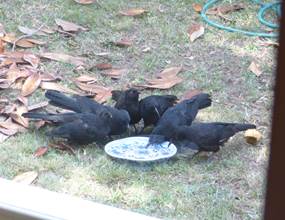I think you’ll find this comes from ‘powder-down’, special small body feathers that break down into a slightly greasy talc-like substance that some birds use in feather dressing (as these happy pigeons seem to be doing). I’ve also seen
powder down on herons and parrots, and a very clear powder outline of the flight feathers where a pigeon has hit a window. It gives a whitish bloom to the feathers of some birds – I knew a rescued Galah that hadn’t learned to distribute its powder properly
and its pink feathers were much brighter than its better-groomed mate.
Alison
From: Robin Hide <>
Sent: Thursday, 31 January 2019 11:30 AM
To: Canberra Birds <>
Subject: [canberrabirds] oil and feral pigeons?
According to Wiki, pigeons are one of several bird families that lack a
uropygial gland, “informally known as the preen gland or the oil gland, is a bilobed sebaceous
gland possessed by the majority of birds”
https://en.wikipedia.org/wiki/Uropygial_gland
However, when (unwelcome) feral pigeons use our bird bath, they leave the water surface covered with a whitish, I assume, oily substance, as shown here:

In contrast, the water remains clear after use by all other species (Red Wattle Birds, Magpies, Magpie Larks, ravens, Crimson Rosellas, starlings , etc etc).
Any suggestions about the source of this substance?
Robin Hide
With the current heat , even the rarely visiting choughs wanted water:


